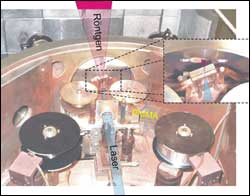Swinging Atoms – ultrashort flash of x-rays images atomic motions

The photograph shows the inside of a vacuum chamber, in which a high-intensity laser beam (blue) is focused into a very small spot (diameter 1/100 millimeter) by a regular lens. The strong electric field of the laser pulses extracts electrons from the metal surface and accelerates them to one third of the velocity of light. These fast electrons generate high energetic x-rays in the copper tape by means of the same mechanism which is used in conventional x-ray tubes. The wavelength of x-rays (1.5 Angstroems) is smaller than the distance between atoms in a solid, and 3000 times smaller than the wavelength of visible light. The duration of an x-ray flash is 0.1 picoseconds, as short as the laser pulse used to generate it (1 picosecond = 1 millionth of a millionth of a second). This is the exposure time of the x-ray camera. Every laser shot triggers a microexplosion in the copper tape, spreading particles in all directions.For 1000 shots per seconds, the band has to be moved at a velocity similar to a regular tape recorder (golden spools). The focusing lens must be protected by a moving and highly transparent plastic film (black spools).
In the current issue of Science magazine (Vol. 306, Dec. 3, 2004), scientists from the Max-Born-Institute for Nonlinear Optics and Short Pulse Spectroscopy (MBI) in Berlin, Germany, report the direct observation of atomic motions in a semiconductor nanostructure. They use a novel, laser-driven source for ultrashort x-ray pulses to take a movie of atomic motions in a semiconductor nanostructure. “We can observe changes on ultrashort timescales with our femtosecond x-ray diffraction setup”, says Matias Bargheer, who has conducted the work together with Michael Woerner, Nikolai Zhavoronkov and Thomas Elsaesser.
X-rays can be used to look inside objects – think of your security check at the airport or your last visit at the dentist. Checking materials for micro-cracks or the atomic analysis of paint in old masterpieces are additional areas where x-rays are in extensive use. In these every-day applications as well as in fundamental research, the x-ray images are usually static in nature. The state of an object at a certain time or averaged over a time-intervall is pictured. For many applications, however, there is great interest to monitor and analyse processes by recording a sequence of snap-shots. A number of groups worldwide work on the generation of ultrashort x-ray flashes in order to look at elementary processes in nature, such as atomic and molecular motion or the breaking of chemical bonds. Often, these processes occur on time-scales below one picosecond (1 ps), that is a millionth of a millionth of a second.
The nanostructure investigated consists – similar to modern optoelectronic devices – of very thin layers of gallium arsenide (GaAs) and aluminum arsenide (AlAs). An ultrashort laser pulse excites lattice vibrations, i.e. periodic motions of the atoms in the crystal, which are recorded by diffracting an x-ray pulse off the oscillating structure. The very short wavelength of hard x-rays allows for high precision measurements of the atomic positions. A sequence of snapshots is recorded by varying the time delay between excitation and x-ray pulse in steps of approx. 0.1 ps. Although the amplitude of the atoms is 1000 times less than the distance between nearest neighbors, the researchers were able to reconstruct the atomic motion from this movie. They can for the first time unambiguously attribute the generation of the lattice vibrations to the so-called “displacive excitation of coherent phonons”. In this mechanism, the lattice motion is triggered by excitation of electrons, which remain excited during the vibration.
The work in Berlin, which is sponsored by the German Science Foundation (Topical Research Program 1134), demonstrates an unprecedented combination of spatial and temporal resolution. A large number of investigations concerning solids and biomolecular crystals can now be tackled. In a next step the MBI-team wants to look at ultrafast processes in superconductors. “Maybe we can solve the chicken-and-egg problem of phase transitions” says Bargheer. In some cases, it is not known, if the electronic system changes first and then forces the nuclei to adapt to a new configuration, or if the transition proceeds vice versa. Femtosecond x-ray diffraction may also help to clarify many fundamental phenomena where electrons show correlations, for example super-conductivity, magnetism and piezo-electricity.
Contact at the Max-Born-Institute:
Dr. Matias Bargheer, Tel. 030 6392 1472, bargheer@mbi-berlin.de
Dr. Michael Wörner, Tel. 030 6392 1470, woerner@mbi-berlin.de
Prof. Dr. Thomas Elsässer, Tel. 030 6392 1400, elsasser@mbi-berlin.de
Media Contact
More Information:
http://www.mbi-berlin.deAll latest news from the category: Physics and Astronomy
This area deals with the fundamental laws and building blocks of nature and how they interact, the properties and the behavior of matter, and research into space and time and their structures.
innovations-report provides in-depth reports and articles on subjects such as astrophysics, laser technologies, nuclear, quantum, particle and solid-state physics, nanotechnologies, planetary research and findings (Mars, Venus) and developments related to the Hubble Telescope.
Newest articles

NASA: Mystery of life’s handedness deepens
The mystery of why life uses molecules with specific orientations has deepened with a NASA-funded discovery that RNA — a key molecule thought to have potentially held the instructions for…

What are the effects of historic lithium mining on water quality?
Study reveals low levels of common contaminants but high levels of other elements in waters associated with an abandoned lithium mine. Lithium ore and mining waste from a historic lithium…

Quantum-inspired design boosts efficiency of heat-to-electricity conversion
Rice engineers take unconventional route to improving thermophotovoltaic systems. Researchers at Rice University have found a new way to improve a key element of thermophotovoltaic (TPV) systems, which convert heat…



